Search
- Page Path
-
- HOME
- Search
- Perspective
- Infection
- Statement on healthcare system preparedness in response to COVID-19 Omicron subvariants BA.4 and BA.5 surge in Korea from the Korean Pediatric Society and Korean Society of Pediatric Infectious Diseases
- Eun Young Cho, Dong Hyun Kim, Soo-Han Choi, Ki Wook Yun, Jong Gyun Ahn, Hye-Kyung Cho, Hyunju Lee, Jina Lee, Taek-Jin Lee, Byung-Wook Eun, Jin Lee, Dae Sun Jo, Yun-Kyung Kim, Yae-Jean Kim; Committee on Infectious Diseases of the Korean Pediatric Society
- Clin Exp Pediatr. 2022;65(11):510-511. Published online September 23, 2022
-
In order to respond to the recent surge in coronavirus disease 2019 (COVID-19) cases and the continuously changing epidemiology of COVID-19, a sustainable and flexible pediatric healthcare system must be prepared considering the specificity of pediatric care. We demand a more proactive response from the health authorities to check the current state of pediatric COVID-19 patient care and to ensure that pediatric patients receive appropriate and timely management.
- Review Article
- Critical Care Medicine
- Ferritin in pediatric critical illness: a scoping review
- Ivy Cerelia Valerie, Anak Agung Sagung Mirah Prabandari, Dyah Kanya Wati
- Clin Exp Pediatr. 2023;66(3):98-109. Published online September 16, 2022
-

The number of studies on ferritin predictive ability in pediatric critical illness has grown exponentially over the past 2 decades. However, among the 66 of 1,580 studies analyzed here, summary statistics for overall and condition-specific studies were only reported in 45.4% and 71.2%, respectively. In contrast, ferritin as a categorical variable with a preset threshold was a significant predictor in 84.6% of studies.
- Editorial
- Neurobehavior
- Impact of coronavirus disease 2019 on children’s health
- Joon Won Kang
- Clin Exp Pediatr. 2022;65(10):498-499. Published online September 16, 2022
-
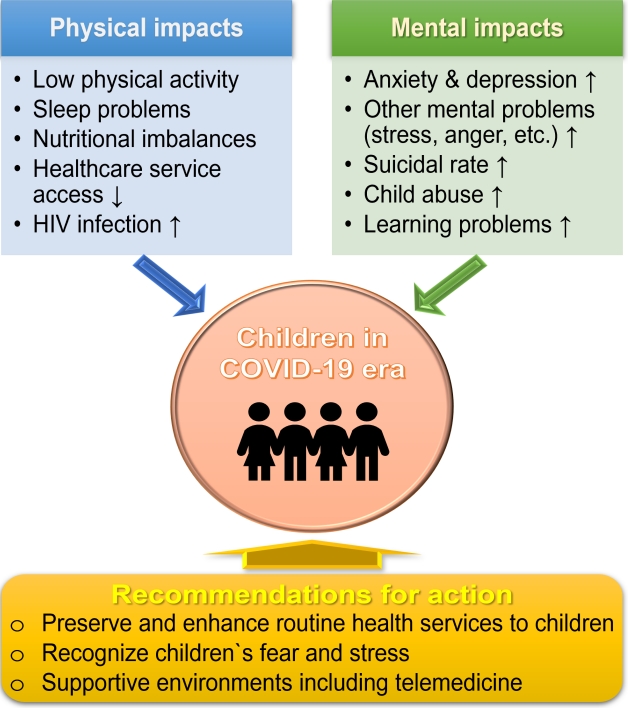
· Coronavirus disease 2019 (COVID-19) has had an enormous impact on mental health and other aspects of children’s health.
· The prevalence of anxiety, depression, and posttraumatic stress disorder in children and adolescents have increased in the COVID-19 era.
· Cooperation among parents, guardians, academic societies, and the government is needed to maintain the mental health of children and adolescents.
- Emergency Medicine
- Current diagnosis and image-guided reduction for intussusception in children: teamwork approach
- Ji-Hyun Seo
- Clin Exp Pediatr. 2023;66(2):66-67. Published online September 1, 2022
-
· The successful and safe enema reduction of intussusception depends primarily on the experience and preference of the radiologists and the availability of resources.
· The establishment of a standardized manual or protocol for reduction and pre-reduction treatment of intussusception, along with the collaboration of pediatricians, radiologists, and surgeons, is expected to improve the treatment success rate.
- Letter to the Editor
- Cardiology
- Early prophylaxis of cardiomyopathy with beta-blockers and angiotensin receptor blockers in patients with Duchenne muscular dystrophy
- Heirim Lee, Jinyoung Song, I-Seok Kang, June Huh, Jin A Yoon, Yong Beom Shin
- Clin Exp Pediatr. 2022;65(10):507-509. Published online August 22, 2022
-
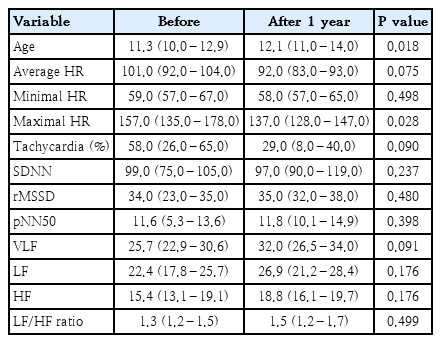
- Original Article
- Neurobehavior
- Association between previous abortion history and risk of autism spectrum disorders among offspring: a meta-analysis
- Ensiyeh Jenabi, Erfan Ayubi, Saeid Bashirian, Mahdieh Seyedi, Mohammad Rezaei
- Clin Exp Pediatr. 2023;66(2):70-75. Published online August 17, 2022
-
Question: This study aimed to determine whether there is an association between previous abortion history and the risk of autism spectrum disorders (ASDs) among children.
Finding: We found that the risk of ASD associated with previous abortion history had an odds ratio of 1.64 (95% confidence interval, 1.28–2.0; I2=61.7%).
Meaning: These findings suggest a positive and significant association between history of previous abortion and risk of ASD in children.
- Editorial
- Nephrology (Genitourinary)
- Hypertension in adulthood is programmed during the perinatal period
- Min Hyun Cho
- Clin Exp Pediatr. 2022;65(10):494-495. Published online August 12, 2022
-
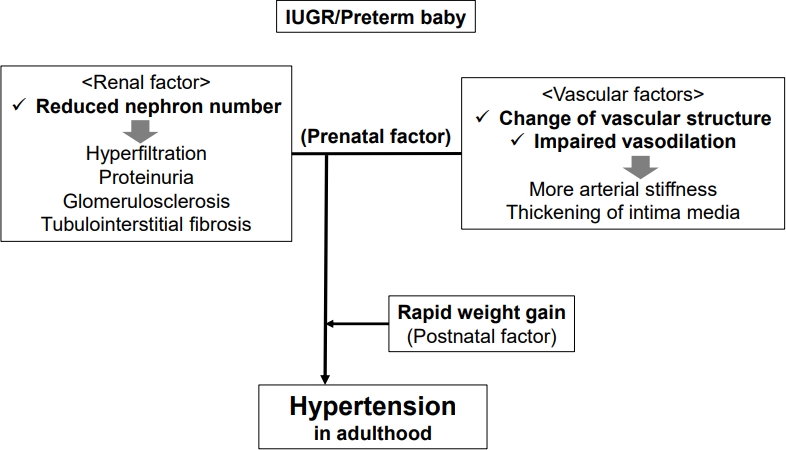
∙ Intrauterine growth restriction (IUGR) and preterm birth can be significant risk factors for the development of adult hypertension.
∙ Several perinatal factors of hypertension are related to IUGR, including renal, vascular, and rapid catch-up growth.
- Original Article
- Nutrition
- Survey of Korean pediatrician’s perceptions of barriers to and improvements in breastfeeding
- Seong Phil Bae, Woo Ryoung Lee, Won-Ho Hahn, Hye-Jung Shin, Young Min Ahn, Son Moon Shin, Yong Joo Kim, Ellen Ai-Rhan Kim, Youn Jeong Shin, Dae Yong Yi, Soon Min Lee, Juyoung Lee, Jin A Lee, Sung-Hoon Chung, Euiseok Jung, Eui Kyung Choi, Ju Sun Heo
- Clin Exp Pediatr. 2022;65(11):540-546. Published online July 29, 2022
-
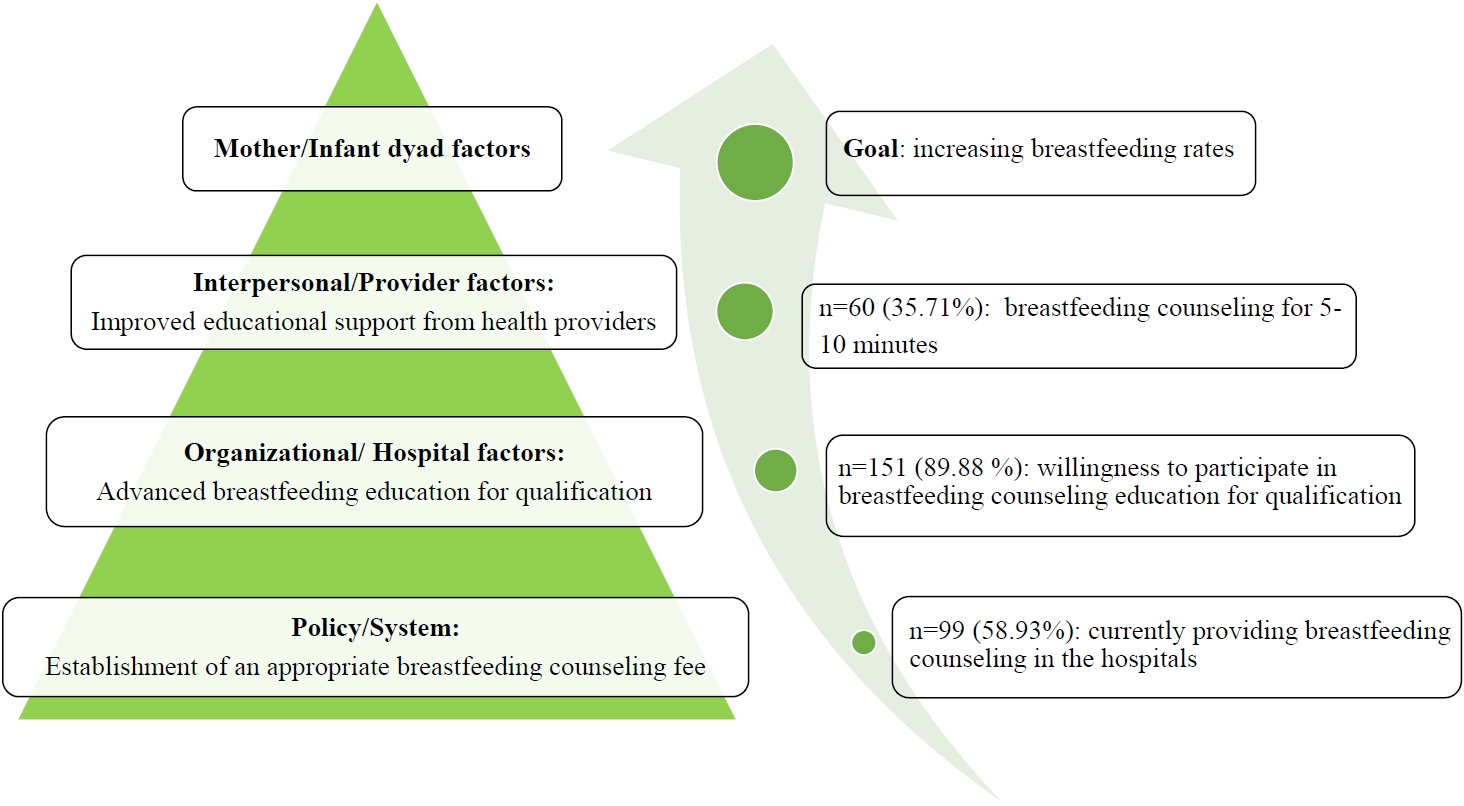
Question: What barriers to breastfeeding do Korean pediatricians perceive?
Finding: Regardless of medical institution, breastfeeding counseling for parents is currently limited, and breastfeeding is commonly discontinued due to various maternal and neonatal factors.
Meaning: To promote breastfeeding, increasing pediatrician participation in breastfeeding counseling with the establishment of appropriate breastfeeding counseling fees and the expansion of practical and high-quality breastfeeding education for medical staff should be considered.
- Neonatology (Perinatology)
- Mediation effect of cord blood cortisol levels between maternal prepregnancy body mass index and birth weight: a hospital-based cross-sectional study
- Nisanth Selvam, Jayashree K, Prasanna Mithra
- Clin Exp Pediatr. 2022;65(10):500-506. Published online July 29, 2022
-

Question: What is the association between cord blood cortisol and maternal weight, birth weight, and cord blood lipid profile?
Finding: Cord blood cortisol levels did not influence the relationship between maternal weight changes or birth weight. Maternal weight changes, birth weight, and cortisol levels altered the cord blood lipid profile.
Meaning: Our findings may aid United Nations Sustainable Development Goal 3 (Good Health and Well-Being) achievement by 2030.
- Editorial
- Endocrinology
- Bisphenol A leaching from polycarbonate baby bottles into baby food causes potential health issues
- Ga Won Jeon
- Clin Exp Pediatr. 2022;65(9):450-452. Published online July 25, 2022
-

Can bisphenol A (BPA) leach out from polycarbonate baby bottles into baby food? BPA and other toxic materials can leach out from baby bottles and increase the risk of various health problems, including endocrine disturbances. Although the use of BPA in baby bottles has been banned, many developing countries still use it, which can cause health issues. Thus, public awareness of this issue is required.
- Cardiology
- Recent research trends in Kawasaki disease-related infection
- Hyang-Ok Woo
- Clin Exp Pediatr. 2022;65(11):538-539. Published online July 22, 2022
-
The incidence of Kawasaki disease has reportedly decreased since the coronavirus disease 2019 (COVID-19) quarantine. However, multisystem inflammatory syndrome in children has reportedly occurred more frequently in areas where COVID-19 was prevalent than in previous years. Research into the etiology of childhood and adolescent systemic vasculitis in infection-related immune responses during the COVID-19 pandemic has increased accordingly.
- Original Article
- Nutrition
- Not breastfeeding and risk of autism spectrum disorders among children: a meta-analysis
- Ensiyeh Jenabi, Saeid Bashirian, Amir Mohammad Salehi, Salman Khazaei
- Clin Exp Pediatr. 2023;66(1):28-31. Published online July 19, 2022
-
This study aimed to determine whether there is an association between not breastfeeding (versus breastfeeding) and the risk of autism spectrum disorders (ASD) among children. We found that the risk of ASD associated with not breastfeeding had an odds ratio of 1.81 (95% confidence interval, 1.35–2.27; I2=0 %). These findings suggest the importance of breastfeeding in decreasing the risk of ASD among children.
- Retraction Notice
- Coronavirus disease 2019 in a 2-month-old male infant: a case report from Iran
- Hosein Heydari, Seyed Kamal Eshagh Hossaini, Ahmad Hormati, Mahboubeh Afifian, Sajjad Ahmadpour
- Clin Exp Pediatr. 2022;65(8):417-417. Published online July 19, 2022
-
- Editorial
- Pulmonology
- Now lung ultrasound has been established as a fundamental examination in pediatric respiratory diseases
- Kyunghoon Kim
- Clin Exp Pediatr. 2022;65(8):401-402. Published online July 13, 2022
-
· Several studies demonstrated the usefulness of lung ultrasound in pediatric respiratory diseases including coronavirus disease 2019.
· Knowledge of lung ultrasound is increasing, and lung ultrasound has been established as a fundamental diagnostic examination for pediatric respiratory diseases.
- Review Article
- Gastroenterology
- Current diagnosis and image-guided reduction for intussusception in children
- Jisun Hwang, Hee Mang Yoon, Pyeong Hwa Kim, Ah Young Jung, Jin Seong Lee, Young Ah Cho
- Clin Exp Pediatr. 2023;66(1):12-21. Published online July 4, 2022
-

· Intussusception, the most common cause of small bowel obstruction in young children, has an overall incidence in Korea of 28.3 cases per 100,000 person-years.
· Its cause is idiopathic inmost cases, although viral or bacterial gastroenteritis has beenpostulated as a cause. Approximately 4% of children have pathological lead points for intussusception, and Meckel’s diverticulum is the most common cause.
· Intussusception in preterm infants is extremely rare. Older children (>5 years of age) are at increased risk of pathological lead points.
- Letter to the Editor
- Developmental and Behavioral Medicine
- The influence of parental eating behaviors, child-feeding practices, and infants’ temperaments upon infants’ eating behaviors
- Goh Woon Lim, Kyoung Min Shin
- Clin Exp Pediatr. 2022;65(9):466-468. Published online June 27, 2022
-

- Review Article
- Infection
- Therapeutics for the treatment of coronavirus disease 2019 in children and adolescents
- Soo-Han Choi, Jae Hong Choi, Ki Wook Yun
- Clin Exp Pediatr. 2022;65(8):377-386. Published online June 27, 2022
-
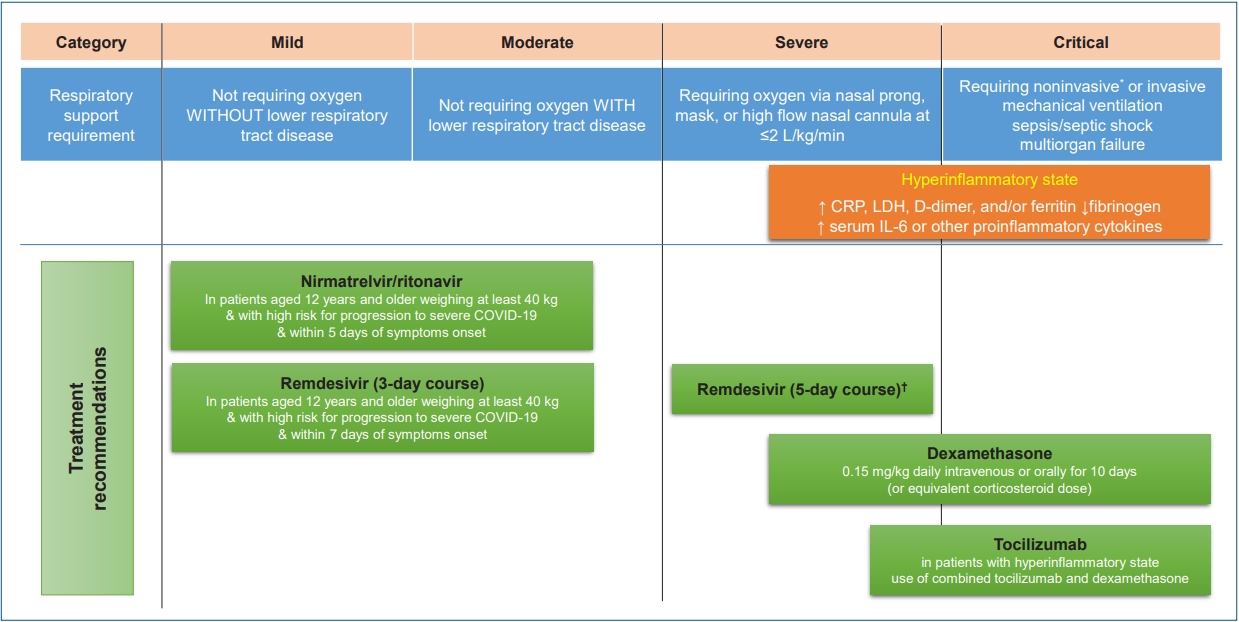
· Children and adolescents with high risks for severe coronavirus disease 2019 (COVID-19) should be identified and proper treatment should be provided promptly according to the patient’s condition.
· Remdesivir can be considered for pediatric patients of all ages with COVID-19 who have an emergent or increase in supplemental oxygen.
· The use of corticosteroids is not recommended for patients with nonsevere COVID-19. Corticosteroids are recommended in children and adolescents with severe and critical COVID-19.
- Clinical Note
- Rheumatology
- Haploinsufficiency A20 misdiagnosed as PFAPA (periodic fever, aphthous stomatitis, pharyngitis, and cervical adenitis) syndrome with Kikuchi disease
- Kyo Jin Jo, Su Eun Park, Chong Kun Cheon, Seung Hwan Oh, Seong Heon Kim
- Clin Exp Pediatr. 2023;66(2):82-84. Published online June 22, 2022
-

- Review Article
- Cardiology
- Research trends on causes of Kawasaki disease in the COVID-19 era: focus on viral infections
- Young Hwan Lee
- Clin Exp Pediatr. 2023;66(1):1-11. Published online June 22, 2022
-
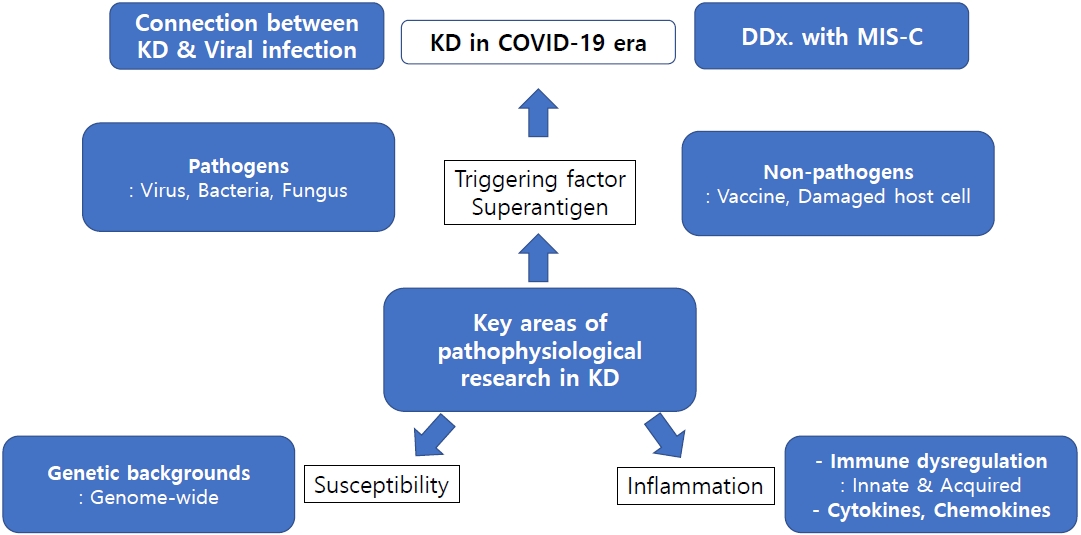
· The etiology of Kawasaki disease (KD) is unclear, but its clinical, epidemiological, and pathophysiological characteristics are strongly associated with infectious diseases.
· In the coronavirus disease 2019 pandemic era, viruses are attracting the most attention. Sudden acute respiratory syndrome coronavirus 2 infection causes various hyperinflammation in children that require differentiation from KD.
· Immune responses in patients with KD may be induced by host cell damage. To effectively prevent and treat KD, the genetic background and immune responses of KD patients and triggering pathogens require identification.
- Clinical Note
- Endocrinology
- Graves’ disease: an uncommon cause of late sequelae following DRESS (drug reaction with eosinophilia and systemic symptoms)
- Therdpong Tempark, Amatanun Tangthanapalakul, Tawatchai Deekajorndech, Susheera Chatproedprai, Vichit Supornsilchai, Siriwan Wananukul
- Clin Exp Pediatr. 2022;65(12):602-604. Published online June 22, 2022
-
- Original Article
- Hematology
- Effect of cyclic pamidronate administration on osteoporosis in children with β-thalassemia major: a single-center study
- Mahmoud A. El-Hawy, Nagwan Y. Saleh
- Clin Exp Pediatr. 2022;65(8):405-409. Published online June 7, 2022
-
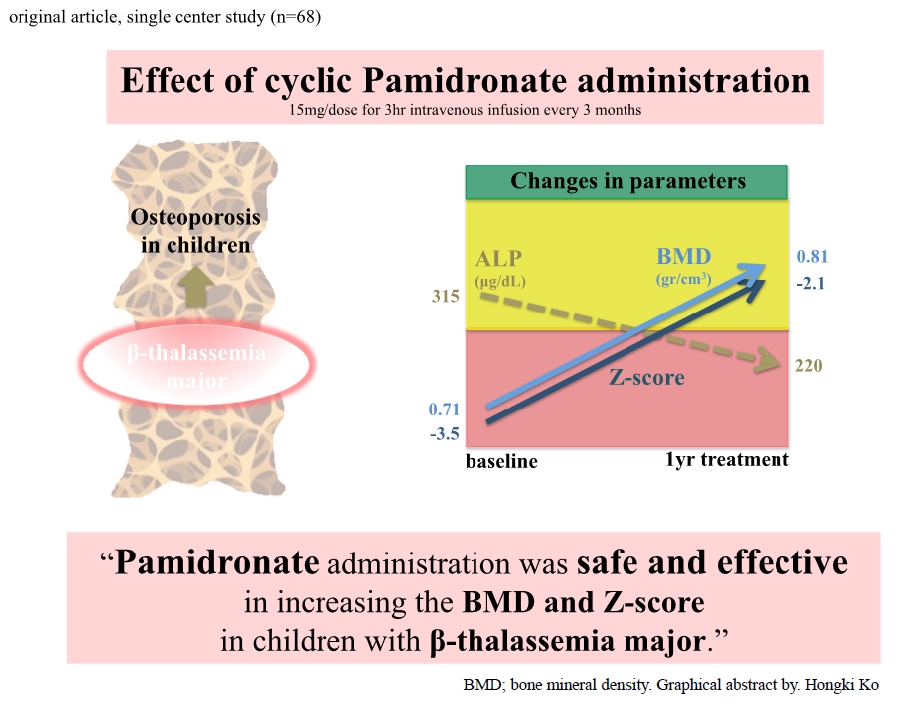
Question: What is the effect of cyclic pamidronate administration on osteoporosis in children with β-thalassemia major?
Finding: The dual-energy x-ray absorptiometry scan findings of children with β-thalassemia major and osteoporosis were improved after pamidronate administration.
Meaning: Cyclic pamidronate effectively treated osteoporosis in children with β-thalassemia major.
- Review Article
- Other
- Epidemiology of pediatric fractures before versus during the coronavirus disease 2019 pandemic
- Chi Hoon Oh, Siyeong Yoon, Kyung Rae Ko, Young Woo Kwon, Kyeong Mi Kim, Hyun Seo Park, Hogyeong Kang, Inseok Jang, Soonchul Lee
- Clin Exp Pediatr. 2022;65(7):330-336. Published online June 3, 2022
-

∙ The novel coronavirus disease 2019 (COVID-19) was first reported in December 2019 as a cluster outbreak in Wuhan, since then, national lockdowns have included school closures, stay-at-home orders.
∙ The characteristics of adolescent fractures were often related to physical activity such as sports-related injury.
∙ During the COVID-19 pandemic, both in the East and the West, the incidence of fractures in children and adolescents is showing a decreasing trend worldwide.
∙ Fractures in children and adolescents were significantly reduced in the proportion of relatively low-energy damage, and the incidence of fractures in adolescents with greater activity compared to children was reduced.
∙ If COVID-19 pandemic ends, normal academic and sports activities increase due to the easing of lockdown policies, the number of trauma patients related to increased activity may increase rapidly, and clinics should prepare for this change.
- Neurobehavior
- Jeopardized mental health of children and adolescents in coronavirus disease 2019 pandemic
- Bohyun Jin, Sohee Lee, Un Sun Chung
- Clin Exp Pediatr. 2022;65(7):322-329. Published online June 3, 2022
-
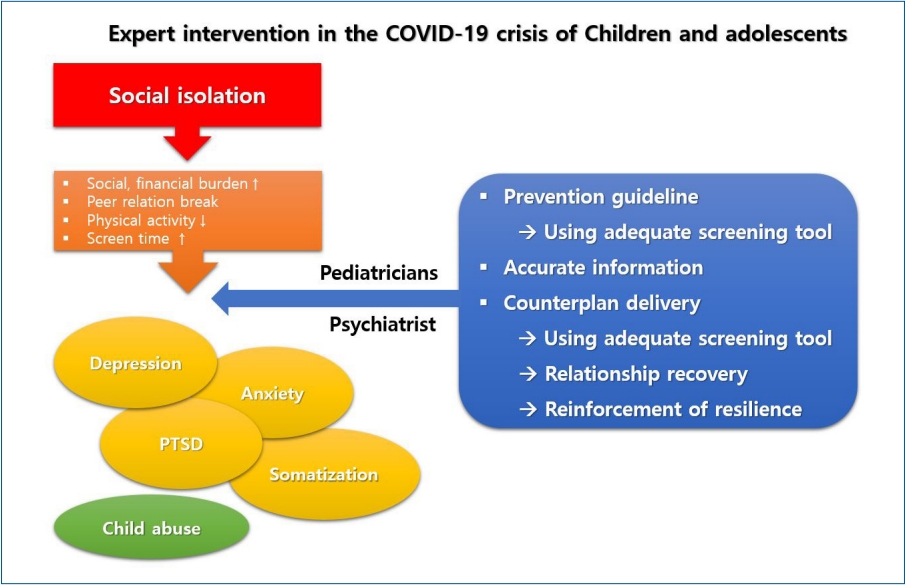
∙ The coronavirus disease 2019 (COVID-19) pandemic has required preventive measures like self-quarantine, school closures, and lockdown, which ultimately make youth directly and indirectly vulnerable to depression, anxiety, posttraumatic stress disorder, and somatization.
∙ Child abuse is more common in the COVID-19 era than previously.
∙ Pediatricians should carefully examine parental and child mental health to directly and indirectly aid their physical and mental health.
- Nephrology (Genitourinary)
- Neonatal hypertension: concerns within and beyond the neonatal intensive care unit
- Kathleen Altemose, Janis M. Dionne
- Clin Exp Pediatr. 2022;65(8):367-376. Published online May 30, 2022
-
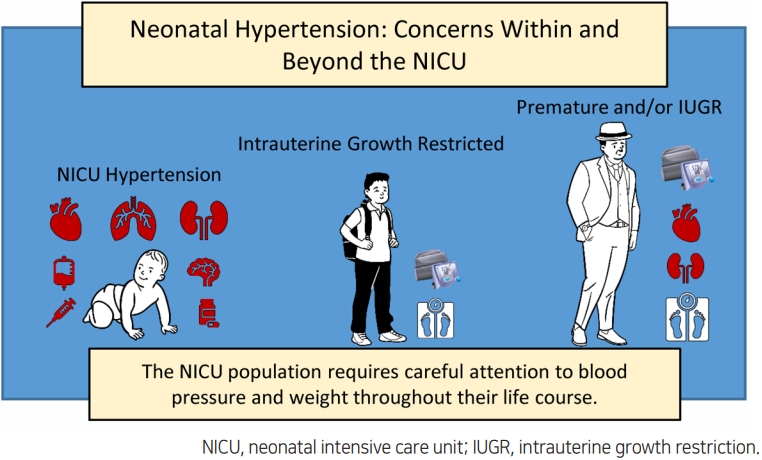
Some neonates, especially those who are premature, may experience hypertension while in the neonatal intensive care unit (NICU). The most common causes are prematurity-related and the hypertension usually resolves over the first 1–2 years of life. Unfortunately, the increasing population of NICU graduates is at risk for later cardiovascular and kidney disease in childhood and adulthood. This population requires careful attention to blood pressure and weight throughout their life course.
- Original Article
- Oncology
- Treatment outcomes of high-dose chemotherapy plus stem cell rescue in high-risk neuroblastoma patients in Thailand
- Kunanya Suwannaying, Piti Techavichit, Patcharee Komvilaisak, Napat Laoaroon, Nattee Narkbunnam, Kleebsabai Sanpakit, Kanhatai Chiengthong, Thirachit Chotsampancharoen, Lalita Sathitsamitphong, Chalongpon Santong, Panya Seksarn, Suradej Hongeng, Surapon Wiangnon
- Clin Exp Pediatr. 2022;65(9):453-458. Published online May 24, 2022
-

Question: This study aimed to elucidate the outcomes of high-risk neuroblastoma (HR-NB) patients treated with high-dose chemotherapy and stem cell rescue without immunotherapy.
Finding: The 5-year overall survival and event-free survival rates were 45.1% and 40.4%, respectively.
Meaning: High-dose chemotherapy plus stem cell rescue followed by cis-retinoic acid for 12 months is well tolerated and could improve survival in patients with HR-NB in limited resource settings.
- Other
- Plastic bottle feeding produces changes in biochemical parameters in human infants – A pilot study
- Mahendra K. Pant, Abul. H. Ahmad, Manisha Naithani, Jayanti Pant
- Clin Exp Pediatr. 2022;65(9):459-465. Published online May 19, 2022
-

Question: Plastic feeding bottles are used commonly to feed infants who cannot be breastfeed. Does plastic bottle feeding produce biochemical changes in infants?
Finding: The plastic bottles leach out endocrine disruptors and affects bodily functions in terms of biochemical alterations like increased blood urea, raised creatine-kinase–MB levels, and altered lipid profile in infants exposed to bottle feeding.
Meaning: Plastic bottles feeding alters bodily functions in infants.
- Infection
- Role of lung ultrasound patterns in monitoring coronavirus disease 2019 pneumonia and acute respiratory distress syndrome in children
- Satyabrata Roychowdhoury, Subhajit Bhakta, Manas Kumar Mahapatra, Saptarshi Ghosh, Sayantika Saha, Mithun Chandra Konar, Mihir Sarkar, Mousumi Nandi
- Clin Exp Pediatr. 2022;65(7):358-366. Published online May 13, 2022
-

Question: Potential role of patterns of lung ultrasonography (US) in monitoring changes in mechanically ventilated patients with coronavirus disease 2019 (COVID-19) pneumonia.
Finding: Interstitial syndrome, an irregular pleural line, and peripheral microconsolidation were the most prevalent findings. Changes in lung aeration after mechanical ventilation corelated with improved oxygenation. A fall in lung ultrasound reaeration score ≤ 5 may predict successful weaning.
Meaning: Lung US is gaining wider utility for monitoring COVID-19 pneumonia.
- Editorial
- Other
- Three-dimensional printing technolgy in orthopedic oncology
- Yongsung Kim
- Clin Exp Pediatr. 2022;65(10):496-497. Published online May 11, 2022
-
Orthopedic oncology is one of the most active fields in applying 3-dimensional printing technology from preoperative planning to intraoperative procedures such as accurate resection of tumors and reconstruction of huge bone defects.
- Neurology
- Increasing our understanding of rotavirus-induced central nervous system manifestations
- Jon Soo Kim
- Clin Exp Pediatr. 2022;65(11):536-537. Published online May 6, 2022
-
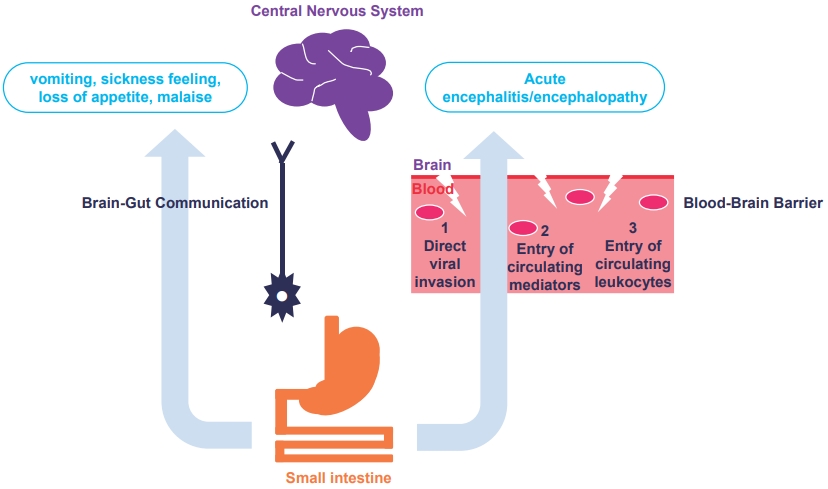
· Diverse clinicoradiological features of central nervous system (CNS) complications in rotavirus infection can be identified with the rapid and wide use of various brain magnetic resonance imaging protocols.
· An increased understanding of the various pathophysiological mechanisms of rotavirus-induced CNS manifestations will enable precise management in the future.
- Pulmonology
- Influence of coronavirus disease 2019 pandemic on respiratory health in children
- Hyo-Bin Kim
- Clin Exp Pediatr. 2022;65(7):348-349. Published online May 3, 2022
-
· Practicing hand hygiene, wearing a mask, maintaining social distancing, and other lockdown measures were implemented to reduce the spread of coronavirus disease 2019 (COVID-19), a worldwide disaster that started in 2019.
· The advent of the worldwide COVID-19 pandemic resulted in positive secondary effects, such as reduced respiratory viral infections in children and decreased degrees of air pollution.
-

-
-
6.02024CiteScore98th percentilePowered by
-
Impact Factor3.6
-
- TOPICS
- ARTICLE CATEGORY
- Editorial Office
-
Korean Pediatric Society
#1606 Seocho World Officetel, 19 Seoun-ro, Seocho-ku, Seoul 06732, Korea
Tel: +82-2-3473-7306 Fax: +82-2-3473-7307 E-mail: office@e-cep.org
Clinical and Experimental Pediatrics is an open access journal. All articles are distributed under the terms of the Creative Commons Attribution NonCommercial License (http://creativecommons.org/licenses/by-nc/4.0/)
Copyright © 2025 by Korean Pediatric Society.











